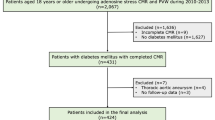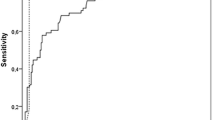Abstract
To investigate the relationship between ascending aortic distensibility (AAD) and hypertensive target organ damage (TOD) and its potential value in prediction. One hundred and sixty seven primary hypertension inpatients who underwent coronary CTA examination were enrolled into our study. Retrospective ECG-triggering scanning mode were applied and the images were reconstructed every 5% phase in the entire R–R interval. Maximum and minimum ascending aortic areas as well as the AAD value were calculated on the interested slice. AAD (P < 0.001) and brachial-ankle pulse wave velocity (baPWV, P < 0.05) were changed significantly as the deterioration of TOD. Multivariate logistic regression analysis between TOD and its possible influence factors indicated that AAD was the only independent risk factor for the presence and severity of TOD. One standard deviation decrease on AAD would increase the risk of TOD significantly: TOD1 (odds ratio 0.45, P < 0.05), TOD2 (odds ratio 0.23, P < 0.05), and TOD3 (odds ratio 0.01, P < 0.05). The odds ratio of TOD in the third tertile group was found 5.47 times higher than that in the second tertile group, and the second tertile group TOD odds ratio was 6.4 times higher than that in the first tertile group. Decline of AAD can be taken as the independent predict factor for TOD in primary hypertension patients, superior to baPWV method and other conventional predictors. Without additional contrast media consumption and radiation dose, AAD derived from coronary CTA may provide early detection for hypertensive TOD.


Similar content being viewed by others
References
Grupo de Trabajo de la SEC sobre la guía de hipertensión arterial ESC/ESH revisores expertos de la guía de hipertensión arterial ESC/ESH 2013 y Comité de Guías de Práctica Clínica de la SEC (2013) 2013 ESH/ESC guidelines for the management of arterial hypertension: the Task Force for the Management of Arterial Hypertension of the European Society of Hypertension (ESH) and of the European Society of Cardiology (ESC). Blood Press 22(4):193–278. doi:10.3109/08037051
Elias MF, Robbins MA, Budge MM, Abhayaratna WP, Dore GA, Elias PK (2009) Arterial pulse wavevelocity and cognition with advancing age. Hypertension 53:668–673. doi:10.1161/HYPERTENSIONAHA.108.126342
Mitchell GF (2004) Arterial stiffness and wave reflection in hypertension: pathophysiologic and therapeutic implications. Curr Hypertens Rep 6:436–441
Lønnebakken MT, Izzo R, Mancusi C, Losi MA, Stabile E, Rozza F et al (2016) Aortic root dimension and arterial stiffness in arterial hypertension: the Campania Salute Network. J Hypertens 34(6):1109–1114. doi:10.1097/HJH.0000000000000932
Coutinho T, Turner ST, Kullo IJ (2011) Aortic pulse wave velocity is associated with measures of subclinical target organ damage. JACC Cardiovasc Imaging 4(7):754–761. doi:10.1016/j.jcmg.2011.04.011
Mitchell GF (2014) Arterial stiffness and hypertension. Hypertension 64(1):13–18. doi:10.1161/HYPERTENSIONAHA.114.00921
Wong DT, Narayan O, Leong DP, Bertaso AG, Maia MG, Ko BS et al (2015) Regional aortic distensibility and its relationship with age and aortic stenosis: a computed tomography study. Int J Cardiovasc Imaging 31(5):1053–1062. doi:10.1007/s10554-015-0640-z
Wang W, Guo W, Liu XP, Jia X, Zhang HP, Zhang MH, Du X (2015) Study of ascending aortic elasticity in the Chinese population with a high risk of aortic diseases. Int J Clin Exp Med 8(3):3381–3390
Redheuil A, Yu WC, Wu CO, Mousseaux E, de Cesare A, Yan R et al (2010) Reduced ascending aortic strain and distensibility earliest manifestations of vascular aging in humans. Hypertension 55(2):319–326. doi:10.1161/HYPERTENSIONAHA.109.141275
Redheuil A, Wu CO, Kachenoura N, Ohyama Y, Yan RT, Bertoni AG et al (2014) Proximal aortic distensibility is an independent predictor of all-cause mortality and incident CV events: the MESA study. J Am Coll Cardiol 64(24):2619–2629. doi:10.1016/j.jacc.2014.09.060
Li N, Beck T, Chen J, Biermann C, Guo L, Sun H et al (2011) Assessment of thoracic aortic elasticity: a preliminary study using electrocardiographically gated dual-source CT. Eur Radiol 21(7):1564–1572. doi:10.1007/s00330-011-2077-7
Schlicht MS, Khanafer K, Duprey A, Cronin P, Berguer R (2013) Experimental foundation for in vivo measurement of the elasticity of the aorta in computed tomography angiography. Eur J Vasc Endovasc Surg 46(4):447–452. doi:10.1016/j.ejvs.2013.07.011
Ma YC, Zuo L, Chen JH, Luo Q, Yu XQ, Li Y et al (2006) Modified glomerular filtration rate estimating equation for Chinese patients with chronic kidney disease. J Am Soc Nephrol 17(10):2937–2944
Wang Y, Yang Y, Wang A, An S, Li Z, Zhang W et al (2016) Association of long-term blood pressure variability and brachial-ankle pulse wave velocity: a retrospective study from the APAC cohort. Sci Rep 6:1–6. doi:10.1038/srep21303
Mitchell GF (2009) Arterial stiffness and wave reflection: biomarkers of cardiovascular risk. Artery Res 3(2):56–64. doi:10.1016/j.artres.2009.02.002
Redfield MM, Jacobsen SJ, Borlaug BA, Rodeheffer RJ, Kass DA (2005) Age-and gender-related ventricular-vascular stiffening a community-based study. Circulation 112(15):2254–2262. doi:10.1161/CIRCULATIONAHA.105.541078
O’Rourke MF, Safar ME (2005) Relationship between aortic stiffening and microvascular disease in brain and kidney cause and logic of therapy. Hypertension 46(1):200–204. doi:10.1161/01.HYP.0000168052.00426.65
Vlachopoulos C, Aznaouridis K, Terentes-Printzios D, Ioakeimidis N, Stefanadis C (2012) Prediction of cardiovascular events and all-cause mortality with brachial-ankle elasticity index a systematic review and meta-analysis. Hypertension 60(2):556–562. doi:10.1161/HYPERTENSIONAHA.112.194779
Yu WC, Chuang SY, Lin YP, Chen CH (2008) Brachial-ankle vs carotid-femoral pulse wave velocity as a determinant of cardiovascular structure and function. J Hum Hypertens 22(1):24–31. doi:10.1038/sj.jhh.1002259
Yamashina A, Tomiyama H, Takeda K, Tsuda H, Arai T, Hirose K et al (2002) Validity, reproducibility, and clinical significance of noninvasive brachial-ankle pulse wave velocity measurement. Hypertens Res 25(3):359–364
Liang W, Chen D, Chen W, Cheng G (2014) The ascending aortic elasticity feature in normotensive subjects: evaluation with coronary CT angiography. Clin Imaging 38(5):686–692. doi:10.1016/j.clinimag.2014.06.003
Author information
Authors and Affiliations
Corresponding authors
Ethics declarations
Conflict of interest
All authors in our study declare that we have no conflict of interest.
Ethical approval
The content of this study is proved by the institution ethics committee of the first affiliated hospital of Dalian Medical University. Our public trials registry number is ChiCTR-RIC-15007482.
Informed consent
Informed consent was obtained from all individual participants included in the study.
Rights and permissions
About this article
Cite this article
Jia, Cf., Wang, Zq., Sun, Xx. et al. Ascending aortic distensibility and target organ damage in primary hypertension without diabetes. Int J Cardiovasc Imaging 33, 1245–1251 (2017). https://doi.org/10.1007/s10554-017-1099-x
Received:
Accepted:
Published:
Issue Date:
DOI: https://doi.org/10.1007/s10554-017-1099-x




